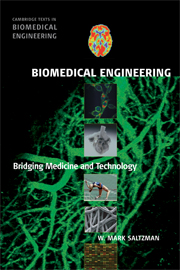Book contents
- Frontmatter
- Contents
- Preface
- Acknowledgments
- Abbreviations and Acronyms
- 1 Introduction: What Is Biomedical Engineering?
- PART 1 MOLECULAR AND CELLULAR PRINCIPLES
- PART 2 PHYSIOLOGICAL PRINCIPLES
- PART 3 BIOMEDICAL ENGINEERING
- 10 Biomechanics
- 11 Bioinstrumentation
- 12 Bioimaging
- 13 Biomolecular Engineering I: Biotechnology
- 14 Biomolecular Engineering II: Engineering of Immunity
- 15 Biomaterials and Artificial Organs
- 16 Biomedical Engineering and Cancer
- Appendix A Physiological Parameters
- Appendix B Chemical Parameters
- Appendix C Units and Conversion Factors
- Index
- Plate section
- References
12 - Bioimaging
from PART 3 - BIOMEDICAL ENGINEERING
- Frontmatter
- Contents
- Preface
- Acknowledgments
- Abbreviations and Acronyms
- 1 Introduction: What Is Biomedical Engineering?
- PART 1 MOLECULAR AND CELLULAR PRINCIPLES
- PART 2 PHYSIOLOGICAL PRINCIPLES
- PART 3 BIOMEDICAL ENGINEERING
- 10 Biomechanics
- 11 Bioinstrumentation
- 12 Bioimaging
- 13 Biomolecular Engineering I: Biotechnology
- 14 Biomolecular Engineering II: Engineering of Immunity
- 15 Biomaterials and Artificial Organs
- 16 Biomedical Engineering and Cancer
- Appendix A Physiological Parameters
- Appendix B Chemical Parameters
- Appendix C Units and Conversion Factors
- Index
- Plate section
- References
Summary
LEARNING OBJECTIVES
After reading this chapter, you should:
Be familiar with current biomedical imaging technology.
Understand the principles behind x-ray, ultrasound, nuclear medicine, optical, and magnetic resonance imaging (MRI) techniques.
Be familiar with some of the scientific and medical applications of these imaging modalities.
Understand the basics of digital image processing and analysis.
Prelude
Biomedical imaging has revolutionized medicine and biology by allowing us to see inside the body and to visualize biological structure and function at microscopic levels. Images are representations of measurable properties that vary with spatial position (and often time). Images can provide exquisitely detailed information about biological structures; the most powerful imaging modalities provide functional information as well, allowing the recording of molecular or cellular processes, or physical properties (such as elasticity or temperature). Methods to visualize and quantify these properties are now available at the macroscopic (i.e., of a size visible to the human eye) and microscopic level. This information can be used clinically for diagnosis and monitoring of treatment as well as scientifically for understanding normal and abnormal structure and physiology.
Technology has brought about remarkable changes in imaging (Figure 12.1). Gene expression can now be imaged using positron emission tomography (PET) imaging—an image creation method that depends on injection of special radioisotopes—coupled with methods from genetics. The brain can be imaged at work on cognitive tasks with functional MRI (fMRI), and that information can be used to guide neurosurgery.
- Type
- Chapter
- Information
- Biomedical EngineeringBridging Medicine and Technology, pp. 432 - 471Publisher: Cambridge University PressPrint publication year: 2009



